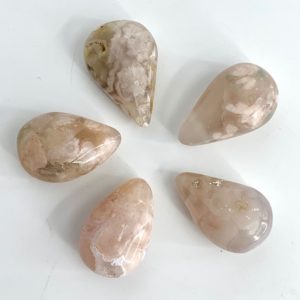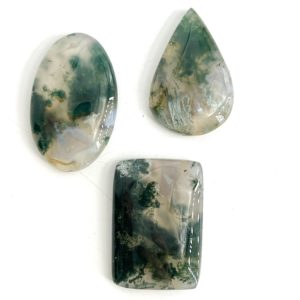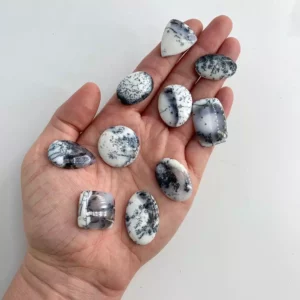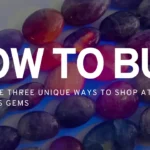Your basket is currently empty!
Everything You Need To Know About Agate From a Gemmologist | Gemmology Lesson

By Marie Chalmers
Agate is the underdog of the Gemstone world! It’s a fascinating material, it forms in the most unusual ways and can be found in abundance all over the world. But, each one is completely unique. Some Agate even grows with smiley faces, what more could you want from a Gemstone?
WHAT IS AGATE?
Agate is a subvariety of the Chalcedony family, which belongs to the Quartz family. The Quartz family is the largest Gemstone family in the world.
Agate grows in a nodular formation, ranging in size from a few centimetres to enormous chunks weighing hundreds of kilos. This is a really affordable Gemstone found in plenitude all over the world, which means it’s affordable for many people, but each variety is just a little bit different.
When Agate nodules are mined, the Miners will slice the Nodules to see what is inside. This is because each one of the variations of Agates will have its very own unique set of patterns and colours. The conditions that were present during the formation of the Agate dictate the appearance.
Agate certainly has an air of mystery about it because Geologists aren’t one hundred per cent sure how it grows.
Most of the theories agree that Agate is created during lava cooling down period. After a volcano erupts, it creates a lava flow which has gases present within it. The lava begins to cool down, and the gases are trapped, causing bubbles and these are called Vesicles. The magma will completely cool down and harden, and these little bubbles will get an outside rim or shell to them, leaving a void. That will create the initial nodule.
A Silica solution then needs to be present. The Silica bearing solution becomes trapped within the Vesicle. This is where it turns into a theory, Geologists are not a hundred per cent sure how the Silica solution gets inside the Vesicle itself; continue reading for some of the great theories.
HOW DOES AGATE GROW?
THEORY ONE
The first theory is called the in-and-out theory. This theory suggests that the Silica solution can actually penetrate into the Vesicle itself and will change over time, sometimes, you’ll get some coming in and sometimes, you’ll get some going out. Hence the name in and out!
THEORY TWO
The other theory suggests that a Silica-rich gel is contained within the Vesicle. It cannot escape because of the hardened outside rim of the Agate nodule. There is a difference in conditions within the earth, which will determine how the Agate is created.
The gas cavities (Vesicles) have been created by the lava flow, and you’ve got a series of bubbles within the lava itself. Now the first thing that has got to happen is the outside of the cavity needs to create its hard shell; this is created by the Silica solution that is contained within the cavity and must happen before the rest of the Agate nodule is formed.
TYPES OF AGATE
The Agate’s patterns and colour will depend on the earth’s different conditions. Over the formation period of the Agate, there will be changing heat and pressures as well as other chemicals present within the Silica solution. A particular set of conditions will show a particular colour offering and banding, whereas a different set of conditions will create an entirely different set of patterns. You often don’t know what you are going to get until you slice the nodule open!
You might get Agate with concentric bands, which is an indication of the different temperatures and pressures that were present as that Agate nodule grew. Sometimes you get Quartz in the centre, and other times you may find vibrant colours.
Some Agates form with the most fabulous patterns! An excellent example of this is Flower Agate, whose inclusions resemble little floral plumes. Flower Agate is also known as Sukara Agate or Cherry Blossom Agate.
 Flat Stone 2 Pack Flat Stone 2 Pack |
 Tear Drop Approx 3.5cm Tear Drop Approx 3.5cm |
 Beads 6mm 38cm Strand Beads 6mm 38cm Strand |
Then you have Dendritic Agate which is a colourless or off-white grey translucent Gemstone with the most remarkable little tree-like or plant-like inclusions, which are known as dendrites (from the Greek for tree-like). These dendrites are created as iron or manganese (generally brown or black oxides) grows within the Agate.

|

|
Moss Agate and your Tree Agates, all of these fabulous formations hold their own value within the marketplace because the customer desires them, they make fabulous Jewellery, they make fabulous collectables, and they’re really quite unusual.
Moss Agate comes in multiple shades of green with inclusions that resemble green moss, hence the name given to this precious Stone. Moss Agate gets its colour through the presence of metals such as iron and chrome. Tree Agate should not be confused with Moss Agate. Whilst it has a very similar formation, Moss Agate has more of a bush-like pattern as opposed to the clearer branches of Tree Agate.

|
WHAT TO USE AGATE FOR?
Agate is brilliant for Jewellery Designers; it’s a very durable Gemstone making it brilliant for use in Jewellery. It is interesting and aesthetically pleasing due to the variety of different colours and patterns it can be found in.
If you’re looking for consistency, you could go for a dyed Black Agate, which would bring uniformity throughout your make, or you can pick out some of those fabulous colours and patterns and make something as completely individual to you as a Designer.
HOW MUCH DOES AGATE COST?
Just like the other Gemstones, it is found in varying qualities, so your lower and more affordable price point Agate is found in mass, but the really unusual pieces such as our smiley face Agate slice and mascot, Iris Agate or Fire Agate have unusual structures will sit at a much higher price point because they’re rarer.
Agate is commonly dyed, that’s because it holds a really good dye due to its really fine structure. It’s perfect for the dying process and unlikely to leak the colour, which means we can dye it any colour you can imagine! You’ll find it in the marketplace in a whole array of dyed colours, making it a really colourful, popular and affordable Gemstone.
WHY ADD AGATE TO YOUR COLLECTION?
Agate has to be in your Collection, it comes in so many different varieties, and it’s such an interesting piece to look at that you can get absolutely everything from your concentric Bands from your Agates, including Quartz, through to your fine quality Agate Slices with your unusual patterns in. There’s such a huge variety, there’s something for every collector, even something like an Orca Agate, which is your black and white, your Iris Agate which shows your unusual optical phenomenons; you’ve got all sorts of variations within the Agate family to make the perfect collectable piece for you.
In conclusion, get some Agate people! It’s honestly one of the best Gemstones; it covers this enormous family, it’s fascinating how it grows, and it’s a fascinating material that comes in so many different qualities and patterns and colours.
You can dye it to make it look however you want. It’s so versatile; a beautiful Gemstone and highly recommended by me as a Gemmologist!
Make sure you follow us across Youtube, Instagram, Facebook and TikTok and do feel free to ask any questions you’d like us to answer if there are any Gemstones you’d like us to cover, then just drop us a comment.
Follow us on:






Leave a Reply